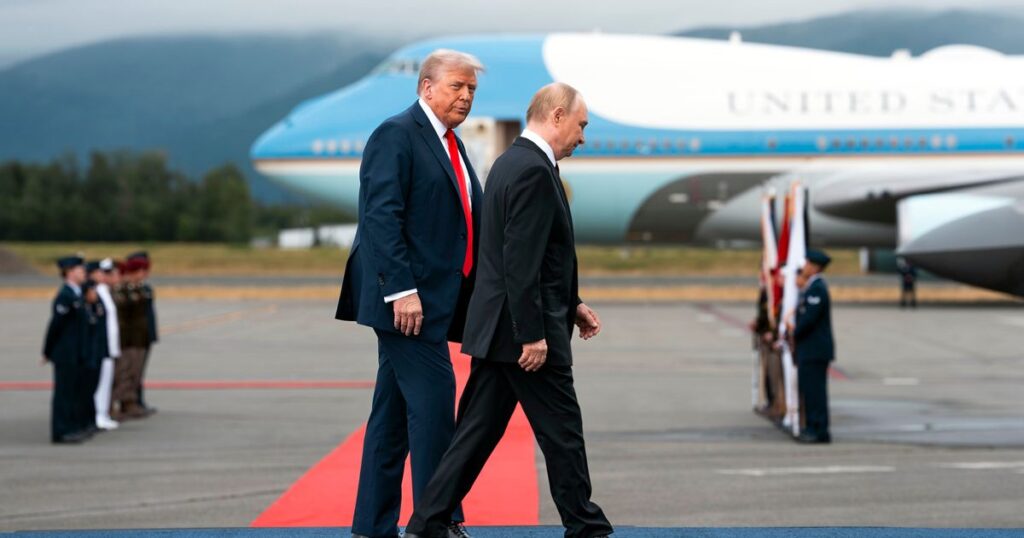President Volodymyr Zelenskyy of Ukraine will visit the White House on Monday for a high-stakes meeting, after President Donald Trump backed Russia’s proposed peace agreement that would require Ukraine to cede a large portion of its territory.
European leaders said Sunday that they would join Zelenskyy, as they strive to present a united front against Russia.
At a meeting between Trump and President Vladimir Putin of Russia on Friday in Alaska, the American leader bowed to Putin’s approach on Ukraine, giving him a free pass to continue his invasive war without further penalty, pending talks on a broader peace deal.
What happened in Alaska?
In the Friday meeting at a U.S. military base in Alaska, Trump adopted Putin’s preference for pursuing a sweeping peace agreement that would require Ukraine to cede territory to Russia.
Trump rolled out a red carpet and applauded Putin, who is under U.S. sanctions and faces an international arrest warrant on war crimes charges. The two laughed and spoke warmly with each other.
At the meeting, Putin offered a ceasefire with Ukraine based on the current battle lines and a written promise not to attack Ukraine or any European country again. Putin has broken similar promises before.
Trump dropped his demand for an immediate ceasefire in favor of a rapid peace treaty that would require Ukraine to cede the Donbas region to Russia, even those areas not occupied by Russian troops.
Skipping ceasefire talks and going straight for a peace deal has been a demand of Putin in the long diplomatic effort to end the war in Ukraine, which began in 2022 when Russia invaded the country. Doing so would also allow Russia to go directly to negotiations over land swaps and other onerous demands on Ukraine.
How did Ukraine and the EU react?
Amid the setbacks for Ukraine, officials in Kyiv found one glimmer of hope. They seized on a U.S. proposal to include security guarantees for Ukraine, designed to deter future Russian aggression, in a potential peace deal.
Trump conveyed the proposal to Zelenskyy in a call early Saturday after the meeting. It would enlist Kyiv’s Western partners to guarantee Ukraine’s defense against new Russian attacks. Crucially, Trump indicated that the United States was ready to participate in such guarantees — a shift from his earlier position that Ukraine’s postwar security should be left solely to Europe.
The outcome of the talks received a chilly reception in Europe, where leaders have time and again seen Trump reverse positions on Ukraine after speaking with Putin. But Ukrainian and European leaders also believe the worst did not happen. Trump did not limit European aid to Kyiv, or agree to hand over chunks of Ukraine to Russia — at least not yet.
The outcome of the Alaska meeting reveals an underlying problem for Ukraine and the Europeans. European leaders have no strategy of their own for ending the war, let alone for defeating Moscow. Instead, they have been racing to keep up with Trump’s variable stances, trying to hold him to certain red lines that protect Ukrainian sovereignty and European security.
For Europe, the fate of Ukraine is of strategic importance.
What happens next?
European leaders said they would join Zelenskyy at the White House as he meets Trump, seeking to avoid being sidelined from talks.
The leaders who plan to accompany Zelenskyy include Germany’s chancellor, Friedrich Merz; President Emmanuel Macron of France; Prime Minister Keir Starmer of Britain; Giorgia Meloni, Italy’s prime minister; NATO’s secretary-general, Mark Rutte; and Ursula von der Leyen, the president of the European Union’s executive arm.
Zelenskyy’s visit will be his first to the White House since he was berated by Trump and Vice President JD Vance in the Oval Office in March in a fiery exchange. The American leaders accused Zelenskyy of not being grateful enough for U.S. support and sought to strong-arm him into making a peace deal on terms the Americans dictated.
What’s the state of the war?
Russia entered Friday’s talks with the United States from a position of strength on the battlefield in Ukraine. It has driven a wedge into Ukrainian defenses in the east, and Ukrainian officials have warned that Moscow has massed forces and equipment for new offensive operations.
In recent days, Russian forces broke through a section of Ukrainian defenses in the eastern Donbas region. Russian troops advanced about 10 miles, threatening to outflank Ukraine’s positions.
The Russian advance has come at a steep price. About 230,000 Russian soldiers have died since the beginning of the invasion, according to estimates based on obituaries collected by the independent news outlet Mediazona and BBC News Russian. Ukrainian losses are estimated at less than half of that figure.
But Moscow has been able to rebuild and even expand its battered forces by tapping into a population that is four times as large as Ukraine’s. Kyiv has struggled to replenish its army through conscription.

